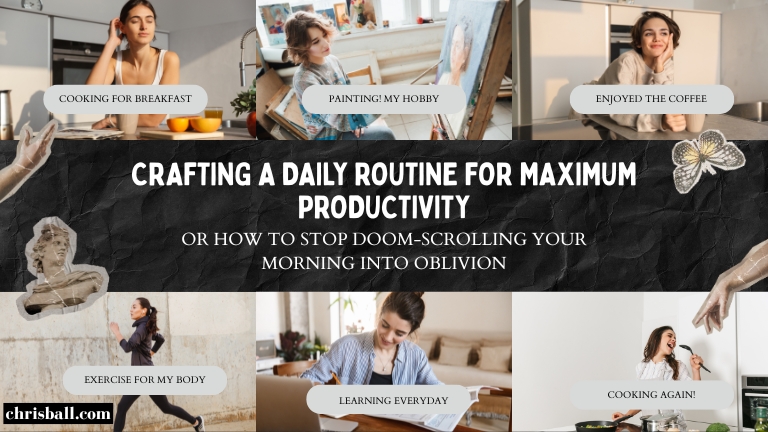Let’s be honest. Most of us don’t wake up like a motivational poster. There’s no sunrise jog, no green smoothie, and definitely no inbox at zero. It’s more like: alarm… snooze… scroll… scroll… oops, late. The day slides forward without structure, and by lunchtime, your brain’s running on caffeine and chaos.
Sound familiar?
Here’s the good news. You don’t need a military-style boot camp to become more productive. You don’t need a five-hour morning routine involving yoga, journalling, and a cold plunge either. You just need a plan—a simple, workable rhythm to your day that stops time from leaking out your ears.
Let’s build that.
Step 1: Start With One Anchor
Forget overhauling your whole life. Just start with one anchor habit—a fixed point in your day that doesn’t move. Maybe it’s starting work at 9am, walking for 20 minutes at 5pm, or doing a brain-dump every night before bed.
Pick one thing you can stick to every day. This isn’t about ambition. It’s about creating a steady beat your day can tap to.
For me, it was setting a “no phone before breakfast” rule. Just that one tweak bought me a quiet window where I wasn’t flooded with news, texts, or cat videos (tempting as they are). That gave me space to choose how I started the day—on purpose, not by accident.
Step 2: Name Your Power Hours
Everyone has a time of day when they can focus more easily. For some, it’s first thing. For others, it’s after lunch or late at night when the house is finally quiet. Identify when you naturally get more done—and protect that time.
Call it what you want: deep work block, creative sprint, brain-on-fire hour. Doesn’t matter. What matters is that you put your most demanding tasks there, and treat it like a meeting with your most important client. (You.)
Start with just one block per day. Ninety minutes is enough. No multitasking. No distractions. Just one priority. Everything else can orbit around it.
Step 3: Create a Micro-Routine for Starting
Getting started is the hardest bit. Once you’re in flow, things often move. So give your brain a warm-up lap.
That could look like:
- Opening your task app and checking today’s three priorities.
- Putting on noise-cancelling headphones and a playlist that tells your brain “it’s work time.”
- Closing all tabs except what you need.
The key is that this routine becomes predictable. You don’t think about it—you just follow it. Over time, this cue builds momentum. Your brain recognises, “Oh, it’s that time,” and shifts into gear.
- Opening your task app and checking today’s three priorities.
Step 4: Make Breaks Real
This part sounds simple, but it’s often skipped. You need real breaks in your routine. Not the kind where you switch from your work screen to your phone screen. The kind where you stand up, move, breathe, maybe even not look at a screen for five minutes.
Try this: work for 50 minutes, break for 10. During that break, do something entirely different—make tea, stretch, water a plant, bother the cat. Anything that isn’t mentally draining.
Your brain resets faster when your break isn’t just a scroll-fest. And oddly, the quality of your breaks will affect how well you work after them.
Step 5: Use Bookends
Start your day on purpose. End it with closure.
Morning bookend? Forget about your 50-item to-do list. Choose the six tasks that are most important for your goals. Then select your top three tasks from them. No more. Just three. Make sure they’re the ones that will make you feel like the day counted—even if everything else gets weird.
Evening bookend? Do a quick review. What went well? What didn’t? What’s tomorrow’s plan?
These bookends signal to your brain: “Work is starting” and “Work is done.” Without them, the day blends into a fog of half-finished things and background stress.
Step 6: Keep It Boring
Yes, really. Routines work best when they’re a bit dull. If you keep reinventing your system every week with new apps, fancy planners, or colour-coded sticky notes, you’re not building a routine—you’re procrastinating in disguise.
A good routine should feel a bit like brushing your teeth. Nothing dramatic. Just there. Regular. Predictable. That’s what keeps it working even when you’re tired, grumpy, or overwhelmed.
Step 7: Make It Yours
Your routine isn’t meant to impress anyone. It’s meant to help you get stuff done without feeling like you’re drowning. If you hate early mornings, don’t force yourself into a 5am start. If you need noise to concentrate, don’t sit in silence like a monk.
The best routines fit you as you are—not as you wish you were. And when they fit, they stick.
So… What’s One Change You Could Make Today?
Could you block out a daily deep work hour? Swap your morning scroll for a five-minute plan? End your day with a quick reflection?
Pick one thing. Just one. Don’t aim for perfect—aim for possible. Then do it again tomorrow.
Want More Tools Like This?
If you’ve nodded along while reading this—or if you’ve laughed and thought, “Yep, that’s me…”—there’s more where that came from. Stop Putting It Off! How To Work When You’d Rather Watch Cat Videos is full of practical, funny, and genuinely doable ways to fix your procrastination problem without needing a personality transplant.
You can get the book completely free when you subscribe to our newsletter. No spam. Just real tips that work—and the occasional story about how cleaning an oven became a full-blown productivity strategy.
So go on. Start the routine. Grab the book. Take the next small step.
One decision now can save you a hundred wobbly ones later.
